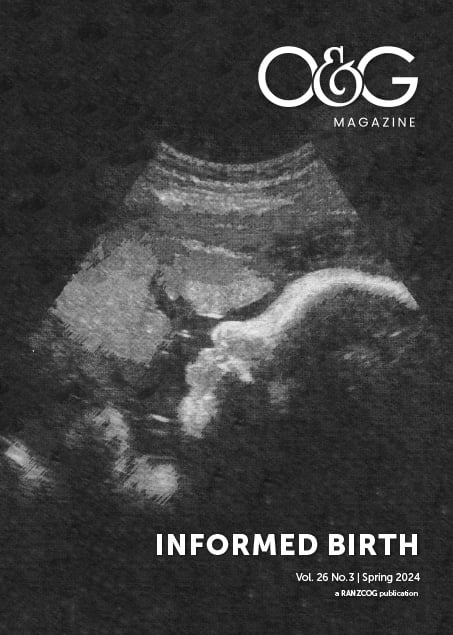Over the last few years there has been a sharp increase in the level of media attention on pregnancy and childbirth, and more specifically, the voices and experiences of mothers. Naturally, Australia’s maternity services have come into focus in a big way. In November 2022, the ABC News network launched The Birth Project, a year-long “quest to explore childbirth (and beyond) in Australia”.1 This has served as a catalyst for a steady flow of articles highlighting the rising rate of intervention, birth trauma and by association, the wave of interest in freebirth.
The following year, the NSW Parliament launched an inquiry into birth trauma. This cast a wide and public spotlight on the very real, relatable and in some cases devastating experiences of birthing mothers across the state. This also happened to be the year that I was working as an unaccredited obstetrics registrar in Sydney, anxiously preparing for my upcoming interview to be accepted onto the RANZCOG training program.
Fast forward to early 2024, and I was thrilled to begin my journey as an accredited trainee. Three months into my training, the recommendations from the birth trauma inquiry were released. Safe to say, it has been an interesting time to be immersed in the birth world. The findings and recommendations of the inquiry have sparked many conversations among my peers about the rewarding, yet challenging and often raw profession that is obstetrics.
One theme that continues to emerge in discussions is the role of social media. A few years ago, Instagram may not have been considered relevant in the broader conversation of childbirth, maternity care and birth trauma. But somewhere along the line, social media evolved beyond selfies to serve as a powerful platform for the dissemination of health information. In the context of childbirth, we can’t deny the influence of social media on education and decision making.

Perhaps this was an inevitable evolution, however COVID-19 and the events of 2020 undeniably played a role. As the COVID-19 pandemic took hold, I was in my intern year, the world was locked down and as healthcare workers, we faced the brunt of its effects. Women were birthing in isolation, without receiving basic antenatal education and were confronted with the need to make decisions among a rise in vaccine hesitancy, all while navigating the very valid fear of becoming unwell with COVID-19 during pregnancy.
It was during this time that Instagram pages such as “Birth with Beth” were created. Many health professionals who were navigating this climate of immense uncertainty saw a desperate need for publicly available, free and evidence-based birth education. Beth Ryan, the founder of this page is a registered midwife with a Masters of Public Health. Five years on, her page has amassed a following of over 47,000 people who engage with her educational content on a daily basis. But Beth is certainly not alone. The post COVID-19 era has seen a steep rise in the number of accounts offering up information and women’s health is a hot topic.
So, what does it mean for our patients and birthing-parents to consume platforms like Instagram and Tik-Tok that are both extremely influential and largely unregulated?
It’s a question well worth considering and one that was explored by a 2023 Queensland-based systematic review.2 The review endeavoured to better understand the impact on birthing parents utilising social media in a time of heightened vulnerability to influence. More specifically, it homed in on the impact of following social media ‘influencers’ and ‘bloggers’ who specifically generate content relating to pregnancy, birth and early parenting.
Clear benefits were identified, namely those relating to the increased ability to connect with others during a season of life that can feel isolating. One study reported that over 83% of people surveyed considered their social media “friends” a source of support in motherhood.
Equally however, the potential harms of misinformation and monetisation were demonstrated. Influencers hold unique power whereby, unlike registered health professionals, they are free to express their views and perspectives relating to health without ethical or legal ramifications.
This presents an extremely challenging online environment for both parents and health professionals alike. Traditionally, the birth education space was dominated by healthcare practitioners. Now, anyone with an account can disseminate health information.
While this (understandably) sounds frightening, it is also worth interrogating the lack of evolution in the way education is delivered in mainstream antenatal settings.
The question must be asked: Is the way that we deliver education in public maternity services outdated?
Women are provided with print flyers, expected to read posters in waiting rooms and invited to join group Zoom calls, when in reality; it is more convenient and enticing to absorb information in the form of snappy social media posts, short-form video and digital courses. But the issue remains, where accuracy and a lack of nuance continues to be at the heart of this challenge.
Rising interest in the freebirth movement serves as a powerful example of the way in which social media can influence the culture around childbirth. In a recent ABC article The Price of Freebirth, Professor Hannah Dahlen, Australia’s leading midwifery researcher quite aptly described the dichotomy between hospital-based obstetric care and the freebirth movement as a “massive chasm between two imperfect worlds.”3 A chasm, we see stretched even further by conflicting information presented on social media.
The very nature of social media requires information to be flattened. 30-second videos and strict word limits lend themselves to the rise of black and white statements. The allure of ‘engagement’ also encourages creators to publish emotive content that snags the attention of their followers. When you have a topic as varied and complex and childbirth, this is a major issue. This point feels particularly challenging because as O&G registrars a large part of our role is to present up-to-date information in a way that is accessible and support women to make individualised and informed choices. But rather than feeling challenged, particularly by social accounts that offer vastly different perspectives from our own, perhaps we should take this crucial opportunity to reflect on our own role in the conversation.
The issues explored here are big, blurry and they are not going to resolve any time soon. But they do deserve our consideration and thankfully, we have colleagues dedicating time and research into the topic. To finish off, I leave you with two questions that continue to come up for me and for my peers:
As maternity providers, do we have a responsibility to evolve and stop treating social media as something to be cautious of?
Should we accept that social media has become an accessible and therefore integral part of health education and be more proactive in joining the chorus of voices in an effort to balance misinformation online?
References
- The Birth Project: A year-long investigation into birth and beyond. (2022). ABC News. [online] 3 Nov. Available at: abc.net.au/news/health/2022-11-03/birth-project-australia-abc-investigation/101574750 [Accessed 1 Jul. 2024].
- Chee RM, Capper TS, Muurlink OT. The impact of social media influencers on pregnancy, birth, and early parenting experiences: A systematic review. Midwifery. 2023 May;120:103623. doi: 10.1016/j.midw.2023.103623. Epub 2023 Feb 19. PMID: 36841131.
- King, C. and Burns, A. (2024). The price of freebirth. ABC News. [online] 23 Feb. Available at: abc.net.au/news/2024-02-24/women-and-doulas-shun-medical-system-in-freebirth-revolution/103430942 [Accessed 1 Jul. 2024].






Leave a Reply